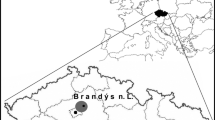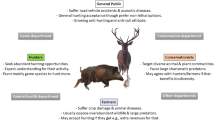Abstract
The interaction between hunting interests and legally protected predators is often a contentious conservation problem, requiring detailed understanding of predator responses to game management. This issue was addressed in southern Portugal in a treatment-control natural experiment, whereby the abundances of small game, corvids, birds of prey and carnivores were compared in 12 game estates (>500 ha) and 12 matching areas with similar sizes and land uses but no game management. European rabbits (Oryctolagus cuniculus), Iberian hares (Lepus granatensis) and, less so, red-legged partridges (Alectoris rufa) were far more numerous in game estates than elsewhere. Among legally controlled species, there were less Eurasian jays (Garrulus glandarius) but more red foxes (Vulpes vulpes) in game estates, though the latter were primary targets of predator culling. Fox abundance within game estates varied inversely with an index of management intensity (density of small game feeding sites) and increased along with hare abundance. As for protected species, only common kestrels (Falco tinnunculus) and genets (Genetta genetta) were fewer in game estates. The abundance of raptors within game estates varied inversely with gamekeeper density, whereas that of common buzzards (Buteo buteo) increased along with rabbit abundance. Overall, there was little evidence that game management reduced local predator abundances, except in the most intensively managed estates. Game estates provided concentrations of prey that was scarce elsewhere, which may have favoured increased abundances of some predators. Further investigations are needed to find out whether high prey densities may attract predators to game estates with increased mortality risk, which may thus become population sinks for protected species.



Similar content being viewed by others
References
Baker PJ, Harris S (2006) Does culling reduce fox (Vulpes vulpes) density in commercial forests in Wales, UK. Eur J Wildl Res 52:99–108. doi:10.1007/s10344-005-0018-y
Baines D, Moss R, Dugan D (2004) Capercaillie breeding success in relation to forest habitat and predator abundance. J Appl Ecol 41:59–71. doi:10.1111/j.1365-2664.2004.00875.x
Barea-Azcón JM, Virgós E, Ballesteros-Duperón E, Moleón M, Chirosa M (2007) Surveying carnivores at large spatial scales: a comparison of four broad-applied methods. Biodivers Conserv 16:1213–1230. doi:10.1007/s10531-006-9114-x
Bibby CJ, Burgess ND, Hill DA, Mustoe S (2000) Bird census techniques, 2nd edn. Academic, London
Borralho R, Rego F, Pinto PV (1996a) Is driven transect sampling suitable for estimating red-legged partridge Alectoris rufa densities. Wildl Biol 2:259–268
Borralho R, Rego F, Palomares F, Hora A (1996b) The distribution of the Egyptian mongoose Herpestes ichneumon (L.) in Portugal. Mammal Rev 26:1–8. doi:10.1111/j.1365-2907.1996.tb00143.x
Borralho R, Rito A, Rego F, Simões H, Pinto PV (1998) Summer distribution of Red-legged Partridges Alectoris rufa in relation to water availability on Mediterranean farmland. Ibis 140:620–625. doi:10.1111/j.1474-919X.1998.tb04707.x
Burfield I, van Bommel FPJ (2004) Birds in Europe: populations estimates, trends and conservation status. BirdLife International, Cambridge
Carvalho J, Castro-Pereira D, Capelo M, Borralho R (1998) Red-legged partridge (Alectoris rufa) restocking programs: their success and implications on the breeding population. Gib Faune Sauv 15:465–474
Cohen J (1988) Statistical power analysis for the behavioural sciences, 2nd edn. Lawrence Erlbaum, New Jersey
Costa L, Nunes M, Geraldes P, Costa H (2003) Zonas Importantes para as Aves em Portugal. Sociedade Portuguesa para o Estudo das Aves, Lisboa
Côté IM, Sutherland WJ (1997) The effectiveness of removing predators to protect bird populations. Conserv Biol 11:395–405. doi:10.1046/j.1523-1739.1997.95410.x
Delibes-Mateos M, Redpath SM, Angulo E, Ferreras P, Villafuerte R (2007) Rabbits as keystone species in southern Europe. Biol Conserv 137:149–156. doi:10.1016/j.biocon.2007.01.024
Delibes-Mateo M, Ferreras P, Villafuerte R (2008a) Rabbit (Oryctolagus cuniculus) abundance and protected areas in central-southern Spain: why they do not match? Eur J Wildl Res. doi:10.1007/s10344-008-0216-5
Delibes-Mateo M, Ferreras P, Villafuerte R (2008b) Rabbit populations and game management: the situation after 15 years of rabbit haemorrhagic disease in central-southern Spain. Biodivers Conserv 17:559–574. doi:10.1007/s10531-007-9272-5
Duarte J, Vargas JM (2001) Son selectivos los controles de predadores en los cotos de caza? Galemys 13:1–9
Etheridge B, Summers RW, Green RE (1997) The effects of illegal killing and destruction of nests by humans on the population dynamics of the hen harrier Circus cyaneus in Scotland. J Appl Ecol 34:1081–1105. doi:10.2307/2405296
Ferrer M, Negro JJ (2004) The near extinction of two large European predators: super specialists pay a price. Conserv Biol 18:344–349. doi:10.1111/j.1523-1739.2004.00096.x
Garzón J (1974) Contribución al estudio del estatus, alimentación y protección de las Falconiformes en España Central. Ardeola 19:279–330
Gortázar C, Villafuerte R, Martín M (2000) Success of traditional restocking of red-legged partridge for hunting purposes in areas of low density of Northeast Spain. Z Jagdwiss 46:23–30. doi:10.1007/BF02240661
Gortázar C, Ferreras P, Villafuerte R, Martín M, Blanco JC (2003) Habitat related differences in age structure and reproductive parameters of red foxes. Acta Theriol (Warsz) 48:93–100
Graham K, Beckerman AP, Thirgood S (2005) Human–predator–prey conflicts: ecological correlates, prey losses and patterns of management. Biol Conserv 122:159–171. doi:10.1016/j.biocon.2004.06.006
Green RE, Etheridge B (1999) Breeding success of the hen harrier Circus cyaneus in relation to the distribution of grouse moors and the red fox Vulpes vulpes. J Appl Ecol 36:472–483. doi:10.1046/j.1365-2664.1999.00419.x
Hakkarainen H, Korpimäki E (1996) Competitive and predatory interactions among raptors: an observational and experimental study. Ecology 77:1134–1142. doi:10.2307/2265582
Harding EK, Doak DF, Albertson JD (2001) Evaluating the effectiveness of predator control. The non-native red fox as a case study. Conserv Biol 15:1114–1122. doi:10.1046/j.1523-1739.2001.0150041114.x
Iborra O, Lumaret JP (1997) Validity limits of the pellet group counts in wild rabbit (Oryctolagus cuniculus). Mammalia 61:205–218
Kauhala K, Helle P, Helle E, Korhonen J (1999) Impact of predator removal on predator and mountain hare populations in Finland. Ann Zool Fenn 36:139–148
Kauhala K, Helle P, Helle E (2000) Predator control and the density and reproductive success of grouse populations in Finland. Ecography 23:161–168. doi:10.1111/j.1600-0587.2000.tb00271.x
Mañosa S, Real J, Codina J (1998) Selection of settlement areas by juvenile Bonelli’s eagle in Catalonia. J Raptor Res 32:208–214
Martínez J, Viñuela J, Villafuerte R (2002) Socio-economic aspects of gamebird hunting, hunting bags and assessment of the status of gamebird populations in REGHAB countries. Part 1: Socio-economic and cultural aspects of gamebird hunting. Report on Workpackage 1 of the European Project REGHAB N° EKV-2000-00637
McDonald RA, Harris S (2002) Population biology of stoats Mustela erminea and weasels Mustela nivalis on game estates in Great Britain. J Appl Ecol 39:793–805. doi:10.1046/j.1365-2664.2002.00757.x
Messmer TA, Brunson MW, Reiter D, Hewitt DG (1999) United States public attitudes regarding predators and their management to enhance avian recruitment. Wildl Soc Bull 27:75–85
Newton I (1993) Predation and limitation of bird numbers. Curr Ornith 11:143–198
Oldfield TEE, Smith RJ, Harrop SR, Leader-Williams N (2003) Field sports and conservation in the United Kingdom. Nature 423:531–533. doi:10.1038/nature01678
Palma L, Onofre N, Pombal E (1999) Revised distribution and status of diurnal birds of prey in Portugal. Avocetta 23:3–18
Palomares F, Delibes M (1993) Key habitats for Egyptian mongooses in Doñana National Park, South-Western Spain. J Appl Ecol 30:752–758. doi:10.2307/2404253
Palomares F, Gaona P, Ferreras P, Delibes M (1995) Positive effect on game species of top predators by controlling smaller predator populations: an example with lynx, mongooses, and rabbits. Conserv Biol 9:295–305. doi:10.1046/j.1523-1739.1995.9020295.x
Revilla E, Palomares F, Delibes M (2001) Edge-core effects and the effectiveness of traditional reserves in conservation: Eurasian badgers in Doñana National Park. Conserv Biol 15:148–158. doi:10.1046/j.1523-1739.2001.99431.x
Reynolds JC, Tapper SC (1996) Control of mammalian predators in game management and conservation. Mammal Rev 26:127–156. doi:10.1111/j.1365-2907.1996.tb00150.x
Reynolds JC, Angelstam P, Redpath S (1988) Predators, their ecology and impact on gamebird populations. In: Hudson PJ, Rands MRW (eds) Ecology and management of gamebirds. Blackwell, Oxford, pp 72–97
Reynolds JC, Goddard HN, Brockless MH (1993) The impact of local fox (Vulpes vulpes) removal on fox populations at two sites in southern England. Gib Faune Sauv 10:319–334
Sergio F, Blas J, Forero M, Fernández N, Donázar JA, Hiraldo F (2005) Preservation of wide-ranging top predators by site-protection: black and red kites in Doñana National Park. Biol Conserv 125:11–21. doi:10.1016/j.biocon.2005.03.002
Taylor BL, Gerrodette T (1993) The uses of statistical power in conservation biology—the Vaquita and Northern Spotted Owl. Conserv Biol 7:489–500. doi:10.1046/j.1523-1739.1993.07030489.x
Thirgood S, Redpath S, Newton I, Hudson P (2000) Raptors and red grouse: conservation conflicts and management solutions. Conserv Biol 14:95–104. doi:10.1046/j.1523-1739.2000.99013.x
Temple HJ, Terry A (2007) The status and distribution of European mammals. Office for Official Publications of the European Communities, Luxembourg
Turner AS, Conner LM, Cooper J (2008) Supplemental feeding of northern bobwhites affects red-tailed hawk spatial distribution. J Wildl Manage 72:428–432. doi:10.2193/2006-303
Valkama J, Korpimäki E, Arroyo B, Beja P, Bretagnolle V, Bro E, Kenward R, Mañosa S, Redpath SM, Thirgood S, Viñuela J (2005) Birds of prey as limiting factors of gamebird populations in Europe: a review. Biol Rev Camb Philos Soc 80:171–203. doi:10.1017/S146479310400658X
Villafuerte R, Viñuela J, Blanco JC (1998) Extensive predator persecution caused by population crash in a game species: the case of red kites and rabbits in Spain. Biol Conserv 84:191–188. doi:10.1016/S0006-3207(97)00094-3
Viñuela J (1997) Road transects as a large-scale census method for raptors: the case of the Red Kite Milvus milvus in Spain. Bird Study 44:155–165
Viñuela J, Villafuerte R (2004) Predators and rabbits (Oryctolagus cuniculus) in Spain: a key conflict for European raptor conservation. In: Thompson DBA, Redpath S, Fielding AH, Marquiss M, Galbraith CA (eds) Bird of prey in a changing environment. The Stationery Office, Edinburgh, pp 511–526
Virgós E, Travaini A (2005) Relationship between small-game hunting and carnivore diversity in Central Spain. Biodivers Conserv 14:3475–3486. doi:10.1007/s10531-004-0823-8
Virgós E, Tellería JL, Santos T (2002) Effects of geographic location, vegetation type, isolation and fragment features on the richness and occurrence of medium-sized mammals in forest fragments of central Spain. Biodiv Cons 11:1063–1079. doi:10.1023/A:1015856703786
Whitfield DP, McLeod DRA, Watson J, Fielding AH, Haworth PF (2003) The association of grouse moor in Scotland with the illegal use of poisons to control predators. Biol Conserv 114:157–163. doi:10.1016/S0006-3207(03)00019-3
Wilson DE, Cole FR, Nichols JD, Rudran R, Foster M (1996) Measuring and monitoring biological diversity—standard methods for mammals. Smithsonian Institution Press, Washington
Zar JH (1999) Biostatistical analysis, 4th edn. Prentice-Hall, London
Acknowledgements
This study was funded by the Portuguese Foundation for Science and Technology (PRAXIS/C/AGR/11062/1998) and Agência de Inovação. We acknowledge landowners and game managers who allowed access to their property and their willingness to provide information on their game management practices. Thanks are due to Pedro Vaz Pinto, Gonçalo Pessoa, Mário Mota, Silvia Carvalho and Sónia Domingos for help in the field work and to Robert Kenward, Beatriz Arroyo, Steve Redpath, Javier Viñuela and two anonymous referees for the critical reading of the manuscript.
Author information
Authors and Affiliations
Corresponding author
Additional information
Communicated by C. Gortázar
Appendix
Appendix
Rights and permissions
About this article
Cite this article
Beja, P., Gordinho, L., Reino, L. et al. Predator abundance in relation to small game management in southern Portugal: conservation implications. Eur J Wildl Res 55, 227–238 (2009). https://doi.org/10.1007/s10344-008-0236-1
Received:
Revised:
Accepted:
Published:
Issue Date:
DOI: https://doi.org/10.1007/s10344-008-0236-1




